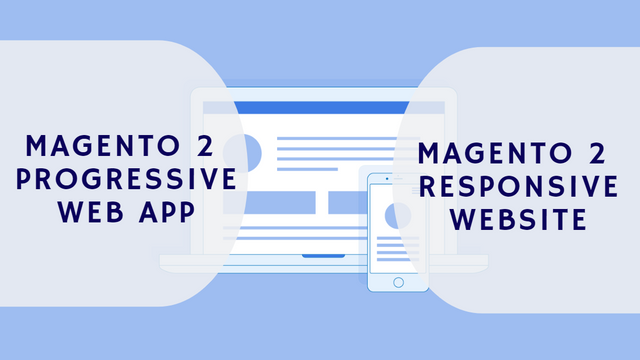
There is no doubt that mobile e-commerce is growing at a spectacular rate, that's why all Magento stores must focus on enhancing the user experience and raising the conversion rates on mobile devices. There are several solutions for that but the most common one is to build a Magento 2 Responsive Website. Besides, the trend of converting the website to Magento 2 Progressive Web App has been raised recently to deal with the same issue.
In this post, we will make a comparison between Magento 2 Responsive Website and Magento 2 Progressive Web App development, in order to figure out which would be a more effective solution for e-commerce online stores.
What is a Magento 2 Responsive Website?
With the dramatic growth of mobile devices, more and more people are using small screens to view web pages.
To deal with that, a Magento 2 Responsive Website is developed with the capability of resizing itself depending on the size of the device used to view the site. In other words, it has only one design but being displayed nicely regardless of the user devices, from desktops, laptops to smartphones and tablets.
From technical perspectives, the website will comprise various layouts, grids, images, and CSS media queries. Owing to that, it will be able to generate proper resolution, images, and scripting abilities for any screen size.
What is a Magento 2 Progressive Web App?
Magento 2 Progressive Web App is a "hybrid" between the websites and mobile apps with the aim of delivering app-like experiences for mobile users. It replaces Magento frontend template (where you can make it responsive or not) with the advanced PWA storefront connected to Magento backend via APIs.
When the users open the website on their browsers, they will see a popup asking their permission to add the PWA on their mobile home screen. Once the PWA is added, there is a shortcut of the PWA on the home screen that looks like normal mobile apps. From then on, the users will have quick access to the store, and more importantly, can enjoy app-like features such as fast page load speed, full-screen display, push notifications, offline mode, and so on.
Below are the demos of Magento 2 Progressive Web App:
Similarities
There are some noticeable resemblances between Magento 2 Progressive Web Apps and Magento 2 Responsive Websites:- Purposes: Both of these solutions are for improving user experience, especially for mobile users.
- Responsive feature: Both Magento 2 PWA and Magento 2 Responsive Websites deliver the changeable look and feel for each user device.
- Codebase: Only a single codebase is required to develop either Magento 2 PWAs or Magento 2 responsive websites. In comparison, if you want to develop native apps, you have to develop one for Android, and another for iOS with two separate codebases.
- SEO benefits: There is only one URL for all devices so it would be easy for the merchants to share and promote their responsive stores or PWAs.
- Ease of user approach: Although the number of mobile users is increasing, more people still prefer visiting the websites (on their browsers) to downloading the mobile apps. Fortunately, both responsive website and PWA for Magento 2 approach the customers through this traditional "entrance".
Differences
At the same time, Magento 2 Progressive Web App differs Magento 2 Responsive Website in many ways:- Popularity: Obviously, more people are familiar with the concept of responsive websites than progressive web apps, a hot trend in the last few years. However, Magento 2 PWA is rising in popularity thanks to its powerful features. Many experts even believe that this technology can replace responsive websites as well as native apps in the future.
- Technology: A responsive website is developed using just HTML and CSS with media queries. Meanwhile, A PWA for Magento is often built based on Magento 2 PWA Studio, ReactJS/ VueJS, and GraphQL.
- Features: Obviously, responsiveness is the sole feature of the responsive websites. A Magento PWA can also deliver the responsive interface, but plus a lot of other features (e.g: icon on homescreen, fast loading speed, push notification, splash page, fullscreen, network independence, background sync, and so on).
- Development process: To have a responsive Magento storefront, you can either design a responsive template or apply a ready-made responsive theme. In general, it will take up to 1 month to build a new template from scratch and just a few hours to install an available theme. On the other hand, if you want to build a PWA for your store from the beginning (with the help of Magento 2 PWA Studio tools), it will take at least 5 months to complete your PWA storefront and API development. That's why many store owners look for Magento 2 PWA integration service to save the time of development, using ready-made PWA theme for Magento 2 instead of starting from 0. It's worth noting that applying a ready-made Magento PWA theme is much more complicated than applying a ready-made Magento responsive theme. You will have to customize the PWA storefront of the theme to make it look likes your current website as well as update the base API to allow your custom functions or extensions.
- Cost of development: Since it takes more time and effort to build a PWA in Magento 2, its associated cost is also significantly higher than developing a responsive design. You might have to pay just $100 to have a ready-made responsive theme and a little extra fee for installation. However, it might cost $3,000-10,000 to convert your store to Magento 2 Progressive Web App. However, remember that you get what you pay for!